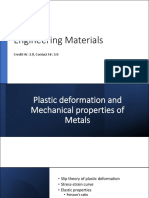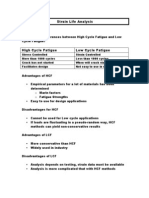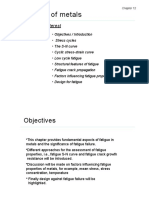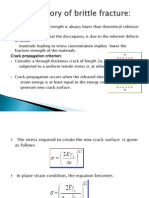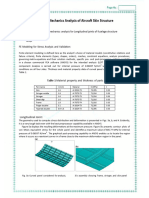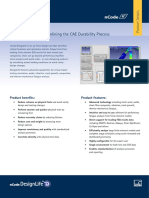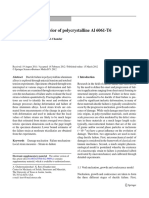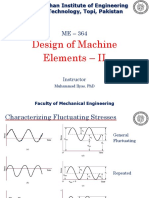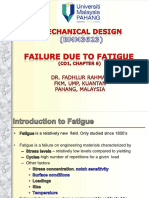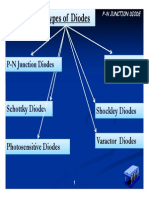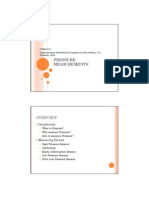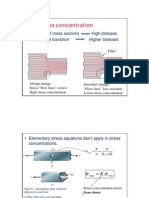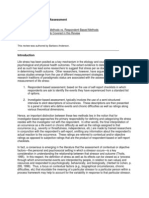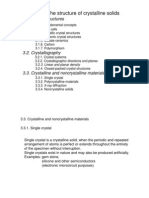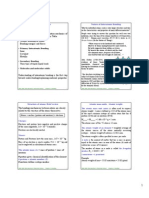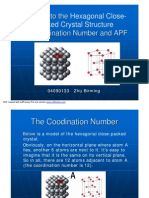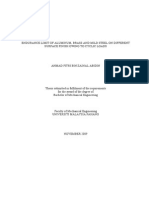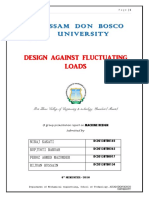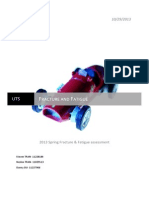Chapter 6 Fatigue Failure Resulting from Variable Loading
Introduction
Under static failure, the stress on the member is constant Problem: static failure, a very large deformation will occur on the structure or machine members. .
�Alternating or fluctuating stresses on member will cause the member subjected to fatigue failure.
�R. R Moore Rotating Beam
Testing specimen Subject to pure bending (no traverse shear) Very well machined and polished No circumferential scratches
�Fatigue Strength and Cycle Graph (S-N Graph) 103
Low Cycle High Cycle Se Finite Life Infinite Life
Cycle Life
Fatigue Strength S f
Endurance limit Se
NA
100
101
102
103
104 105 Cycle, N
106
107
108
�Terminology
N : Cycle : one rotation of the specimen = 1 cycle of alternating stress Sf : fatigue strength is the limit of strength where failure occurs when the alternating stress above the fatigue strength. However, when cycle is larger than 106, the fatigue strength is constant to a value Se. This value is called Endurance Limit Cycle: Cycle is related to the cycle of the specimen: boundary is 103 Life: The life is related to the stress of the specimen: boundary is Se.
Significance to design
9 Designers have a choice to set the design life whether finite life or infinite life. 9 Designers can predict the failure to occur (finite life): i.e. when the stress of the member is sA the predicted life will be NA cycles.
�Endurance limit
Steel
0.5Sut S = 700Mpa
' e
Sut 1400 MPa Sut f 1400 MPa
Eq 6.8 pp 274 Eq 2.17 pp 37
Note: Sut = 3.41 HB Mpa
Notes: Various class of cast iron, polished and machined: Table A-22 pp 1023 Aluminum alloy: does not have an endurance limit, fatigue strength from Table A-22 is set to 5(108) cycles
�Relationship between fatigue strength Sf and cycle N
S f = aN b N = a a
where
1 b
Eq 6.13 and 6.14 pp 277
a: slope of the curve (log vs log) b: Sf @ 103
fS 1 b = log( ut ) 3 Se (f S ut ) 2 a= Se
Eq 6.14 and 6.15 pp 277
�How to determine fatigue strength f @103 1. 2. From Figure 6.18 pp 277 Calculation
f =
'F
Sut
(2 10 3 ) B
log( 'F / Se ) log( 2 Ne ) 'F = Sut + 345 Mpa
Eq 6-10 pp 276
where
B=
Eq 6.12 pp 276 Eq 6.11 pp 276
*Please differentiate between b (6.15) and B (6.12) General equation for fatigue strength
Sf = ' F (2N )B
Eq 6-9 pp 276
�ENDURANCE LIMIT (Se)
Se = k a k b k c k d k eS 'e
where Se : endurance limit based on R.R. Moore experiment ka: surface factor kb: size factor kc: loading factor kd: temperature factor ke:miscellaneous-effects factor Discuss:
Why do we need these variables? What do you expect the value of these variables and why?
�Example Calculate the endurance limit Se, if Material AISI 1010 HR, surface is machined until D = 30 mm, d = 20mm and r (fillet radius) = 2 mm is achieved.
Surface Factor ka
b k a = aS ut
Eq 6.19 pp 279
a and b: Table 6-2 pp 280 Discuss: should the factor a and b be hot rolled or machined.
�Size Factor kb
1.24 d 0.107 kb = 0.157 1.51d
2.79 d 51mm 51 p d 254mm
Eq 6.20 pp 280
Note: only applicable to round rotating shaft due to torsion or bending
Other conditions i. Axial load kb = 1 (for axial load) * Please refer to kc ii. Round non-rotating shaft 95% stress area is applied
A 0.95 = 0.0766 d 2
�A0.95 = 0.0105D 2 0.0766d e = 0.0105D 2
2
d e = 0.37D
iii. iv. For non circular non rotating beam Common non-rotating structural
d e = 0.808( hb )0.5
*Refer to Table 6-3 pp 282 for common non rotating structural
Loading factor kc Bending Axial kc = 1 kc = 0.85 Eq 6.26
Temperature Factor Refer to Table 6-4 pp 283
�Reliability Factor (ke) Refer to Table 6-5 pp 285
�Stress concentration and notch sensitivity
Table A-13: Charts for theoretical Stress Concentration Factor (Kt) For the example above the suitable chart is Figure A-13-9
3.0
Figure A-13-9
2.6
Roundshaft withshoulder fillet Mc inbending, o = ,where I d4 d c = ,andI = Kt 2 64
2.2 D/d=1.5
1.8 1.54
1.4
geometrical property to be used in calculating the stress.
1.0 0
0.05
0.10
0.15 r/d
0.20
0.25
0.30
�Fatigue stress concentration factor (Kf)
K f = 1 + q(K t 1)
Kts: shear stress concentration factor Kfs: fatigue shear stress concentration factor
Eq 6.32 pp 287
K fs = 1 + qshear (K ts 1)
q, qshear : notch sensitivity from Figure 6-20 and 6-21 respectively.
Eq 6.32 pp 287
If the value of notch sensitivity can not be retrieved from the respective figures, the
most conservative assumption is that Kf = Kt or Kfs = Kts
Therefore the maximum stress will be
max = K f 0
or
max = K f 0
Eq 6.30 pp 287
�Combination of loading modes
Combination purely alternating bending, purely alternating axial and alternating torsional stresses Alternating axial stress Alternating bending stress Alternating torsional stress
( axial) = K f ( axial) 0( axial) (bend) = K f (bend) 0(bend) ( torsion) = K fs( torsion) 0( torsion)
Total alternating stress (DET)
( axial) 2 t = + + 3 ( ) ( bend ) ( torsion ) 0.85
*Please note that kc for axial and bending are 0.85 and 1 respectively
�Application of S-N curve to fatigue design.
Infinite life
all =
Se = T n
Finite life
S f = aNb N= a a
1 b
where
a =
T n
Discuss Example 6-8 and 6-9 Question 6-11
Contoh
A
Z
Rajah 1 Rajah 1 menunjukkan sebahagian dari pemegang untuk satu mesin. Pemegang merupakan rod yang dikimpal di A pada mesin tersebut. Rod ini diperbuat dari AISI 1020 HR dan berdiameter 15mm. Jika momen pada A menghasilkan tegasan lenturan ulang-alik a =30 MPa. Daya paksi di A menghasilkan tegasan paksi ulang-alik (ave)a 20MPa. Berdasar kepada data di atas jawab soalan berikut a) b) Kirakan ketahanan lesu (endurance limit) Se bahan tersebut Kirakan faktor keselamatan jika tumpuan tegasan yang disebabkan oleh kimpalan ialah Kf untuk lenturan = 1.7 dan Kf untuk daya paksi = 1.2.
�Fluctuating Stresses
Stress
max : max imum stress
a : amplitude stress
m : midrange stres
min : minimumstress
Midrange Stress
m =
max + min 2
�Alternating Stress
a =
max min
2
Similarly for the fluctuating forces
Midrange Force Alternating Force
Fmax + Fmin 2 F Fmin Fa = max 2 Fm =
These forces will generate respective midrange and alternating stresses.
�How to determine the midrange or alternating stress?
Moment on rotating shaft.
When the shaft rotates in ccw direction, element A will rotate from position 1, 2, 3 and 4 for one full cycle. At the same time, the stresses of A will fluctuate from 0, smax, 0 and smin. Therefore, moment on rotating shaft will generate sa = Mc/I and sm = 0.
Torsion on rotating shaft
Stress
�ta = 0 and tm = Tr/J.
Stress
�Determine the alternating and midrange stresses for the following cases?
Rotating shaft i. Axial load (P) ii. Combination of T and M
Non rotating shaft
Moment (M)
between -10Nm and 10Nm 20 Nm and 50 Nm -30 Nm and 10Nm
Torsion (T)
between 10Nm and 10Nm 20 Nm and 50 Nm -30 Nm and 10Nm
�Fatigue Failure Criteria: graphical and empirical method
A : ( a , m ) B : (a1, m1 ) C : ( a2 , m2 ) D : ( a3 , m3 )
�Graphical Method Goodman line
n=
S a1 Sm1 = a m S a2 Sm2 = a m
S a 3 S m3 = a m
Gerber Failure Theory
n=
Langer Line
n=
�Empirical Method
Goodman Line Basic line equation
Sm S a + =1 S ut S e
For a known (sa, sm)
m
Sut
a
Se
1 n
Gerber Failure Locus (Parabolic Equation)
Sm Basic parabolic equation S ut
For a known (sa, sm)
Sa + =1 S e
2
n m n a + =1 S Se ut
�Langer Line (failure due to yielding) Basic line equation
Sm Sa + =1 Sy Sy
m a 1 + = Sy Sy n
For a known (sa, sm)
Sy a + m
=n
Other failure theories, same principles can be applied.
*In the following discussion, these three theories will be used to demonstrate and similar principle can be applied to other theories.
�Langer line vs. other theories (i.e. Modified Goodman and Gerber Theory)
If the stresses on the member is plotted on the shaded area, the load line of the member will intersect with Langer line first. Therefore, failure due to yielding will occur first. This is type of failure is called Langer-first-cycle failure. Empirically, it can be determined when nlanger < nf(other).
�Procedure in solving the fatigue problem
1. 2. Determine sa, sm, ta and tm. Combine the alternating stresses using DET
2 2 total( a ) = a + 3 a
3.
Combine the mean stresses using DET
2 2 total ( m ) = m + 3 m
4.
Using the theories to solve the problem
Question 6-17, 6-23, 6-26
��103 Low Cycle Finite Life High Cycle Se Infinite Life
Cycle
Life
Fatigue Strength S f
Endurance limit eS
100
101
102
103
104
N A 105
106
107
108
Cycle, N
�Notes
Purely alternating bending stresses ( 0 )
all =
Se =0 n S e = k a k d k c k d k e S 'e = k a k d kc k d
1 S 'e Kf Combination purely alternating bending and purely alternating axial stress
Alternating axial stress Alternating bending stress Total alternating stress
o( a ) o(b)
o = o( a ) + o(b)
Se =0 n
all =
�What is the value of kc and Kf as both factors have different values
Bending Axial : : kb (eq) kc = 1 and Kf from bending kb, k c
0.0778 = 1.23S ut and Kf from axial
Soln : let kb,kc and Kf is common in Se which is equal to 1
Axial stress (assuming n =1)
all =
Se = 0a n 1 K f (a) K f (a) kc ( a ) S 'e = o ( a )
k a kb ( a ) k c ( a ) k d kb = 1 k a 11kd 1S 'e =
o(a)
�Bending stress
all =
Se = ob n 1 K f (b) S 'e = o ( b )
k a kb ( b ) k c ( b ) k d k a 11k d 1S 'e =
K f (b) kc ( b ) kb ( b )
o (b )
Final equation with factor of safety n
K f (b) k a k d S 'e K f ( a ) = o(a) + o(b ) n kc ( a ) kc ( b ) kb ( b )
�CONTOH
A
Z
Rajah 1 Soalan Rajah 1 menunjukkan sebahagian dari pemegang untuk satu mesin. Pemegang merupakan rod yang dikimpal di A pada mesin tersebut. Rod ini diperbuat dari AISI 1020 HR dan berdiameter 15mm. Jika momen pada A ialah (30 10%)Nm dan daya paksi ialah (8 10%) kN. Untuk memastikan getaran diambil kira, 10% ditambah. Berdasar kepada data di atas jawab soalan berikut c) Kirakan ketahanan lesu (endurance limit) Se bahan tersebut d) Tentukan a, m, a dan m jika faktor tumpuan tegasan yang disebabkan oleh kimpalan ialah Kf untuk lenturan = 1.7 dan Kf untuk daya paksi = 1.2. Kirakan faktor keselamatan terhadap kegagalan alahan dan kegagalan lesu. Yang mana akan gagal dahulu : alahan atau lesu?






